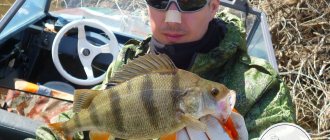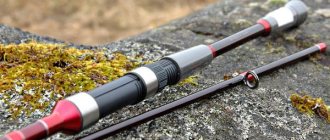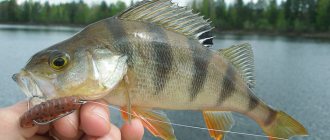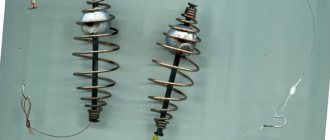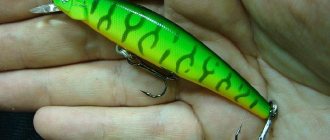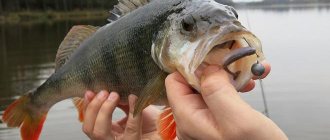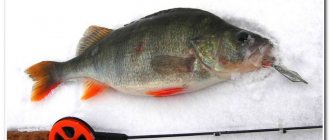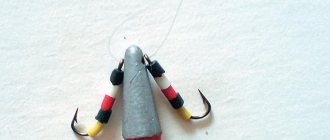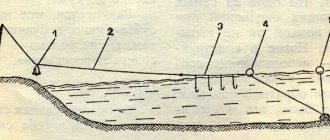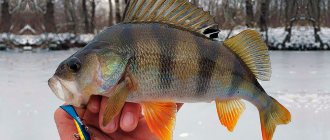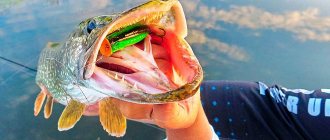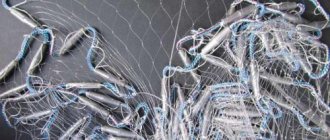Where and when to use a jig
Catching perch with a jig is possible both in standing reservoirs and in fast-flowing rivers. Preference is given to water areas with a hard bottom and depths exceeding a level of two meters. Various kinds of bottom anomalies, underwater hills, depressions, snags and small vegetation affect the quality of the postings, but at the same time significantly increase the success of the hunt. River rapids and all kinds of deep pools are not an obstacle to this method of hunting; rather, on the contrary, it is this type of bait presentation that helps to catch the point most effectively.
Fishing for perch lasts the entire period of open water, differing only in the intensity of bites. Spring and summer are not the most productive periods of the year, but catching perch with a jig in the fall, when the fish gather in huge schools in the pre-winter period, is not difficult. Towards the end of August, the predator begins to fatten up, fattening up for winter, and actively responds to silicone throughout the daylight hours. For a spinning fisher, it is important to identify a promising point where a school of stripers hunts, creating a cauldron of small fish. Having identified a promising place, all that remains is to accurately jig the bait and select the optimal wiring option to get the aggressive and voracious predator out of the water with enviable regularity.
Features of fishing by season
The peculiarities of catching this predator primarily depend on the time of year; below are the basic rules:
- In the spring, the perch fishing season begins immediately after the end of spawning; you should look for prey in shallow water. However, jig baits are not particularly effective during this period; it is much more advisable to use natural baits.
- In summer, it is best to look for perch in rivers, in areas with underwater shelters. Jig fishing becomes popular in early or mid-August.
- The autumn period is also a good choice for jig fishing ; you need to look for perch in reservoirs at a considerable distance from the shore.
- In winter, other methods of catching perch are usually practiced. The predator rarely moves around the reservoir and tries to stay at a considerable depth; its behavior and appetite are determined by weather conditions.
Advantages of jig
The advantages of the method include its versatility, which in practice makes it possible to fish any areas of the waters, despite the great depths and complexity of the bottom topography, and usually these are various snags, which are particularly promising anchorage points for schools of predatory fish. We have already mentioned the availability of equipment and the rod itself in the article. An important factor is the rapid mastery of wiring techniques. Methods of animating baits, even at the first fishing session, become stable performance skills, which is beneficial for beginner spinners who are interested in the perch direction of spinning fishing.
And, of course, the advantage of this dynamic type of hunting includes the variety of silicone fish, which are used as bait based on color, size and even taste parameters.
Advantages
To understand why jig fishing is so popular, it’s enough to list its advantages:
- ease of learning the basic principles of fishing,
- availability of gear, regardless of the financial capabilities of the fisherman,
- a huge number of different baits,
- catchability,
- all-season and universalism,
- a variety of universal and highly targeted equipment.
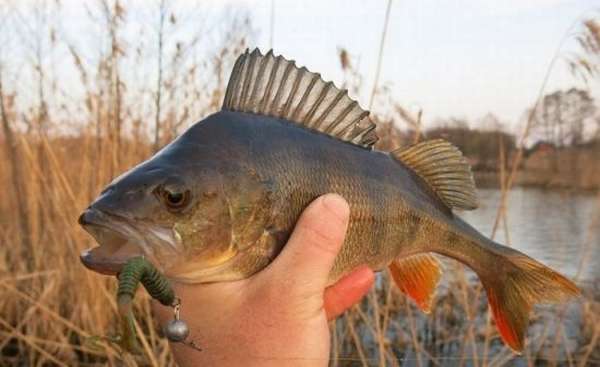
Jig is an excellent method for purposefully catching large perch.
Jig allows you to fish in conditions where other baits are powerless. This is especially true for strong and overgrown places where snags are inevitable. The use of specialized equipment allows you to reduce breakages to a minimum and carry out full-fledged wiring in difficult situations.
Choosing gear for catching perch with a jig
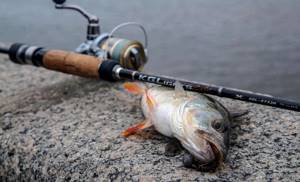
Delicate fishing is undoubtedly associated with the use of delicate gear, which is inextricably associated with perch jigs. Fishing for perch with a microjig especially requires balancing of equipment. According to its physiology, the striped predator has weak lips, which, with strong hooks, simply burst from the stress experienced. Using super-fast fishing rods, you can get a countless number of bites, but not a single trophy can be added to the asset due to the constant disappearance of fish as a result of hooking. We will try to clarify the nuances of assembling the gear in the further course of the article.
Rod
Based on the requirements of tight control of the bait, but a thin and delicate hook, rods are selected with a medium action with a soft, slow tip. Taking into account the size of the supplied baits and their weight, the length of spinning rods is no more than 2.5 meters in the plug version, consisting of two parts. Fast action rods are justified when using monofilament fishing line with small diameters, no more than 0.18 mm, for working at short distances, usually used for fishing from a boat. In such cases, the balance of animation and soft hooking is performed by a well-absorbing monofilament cord.
Coil
Inertia-free lightweight reels with the ability of a spool to ideally fold a thin cord evenly and a sensitive drag ensure guaranteed balancing of the tackle. Such an accessory does not tire your hands with frequent casting and does not tangle the cord with spontaneous resets of loops, and it is these nuances that ensure both the comfort of fishing and its productivity. The drag settings allow you to save bait when hooking and fishing for trophy croakers. The capacity of the spool must ensure storage of at least one hundred meters of line used for fishing.
fishing line
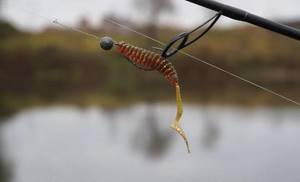
At short fishing distances, they try to work with monofill up to 0.2 mm. When presenting baits 20–25 meters away, it is wise to use thin braided cords in the thickness range from 0.06–0.12 mm.
Important! When jigging on rocky bottoms and shell rocks, preference is given to monofilament lines, since their abrasion is lower than braided lines and, therefore, higher reliability.
These conditions relegate the priority of choosing cord material depending on the distance to the background.
How to choose the weight of a sinker for a jig
Both the twister and the vibrotail perform quite well when catching perch, and here you need to experiment with their sizes and colors. Spinning fishers also successfully use all kinds of silicone crustaceans and worms. According to statistics, red, yellow, and light green are considered catchable colors, but blue and its shades come in second place, but it is impossible to say that these colors will actively provoke the perch to bite, it all depends on the reservoir and the preferences of the perch today.
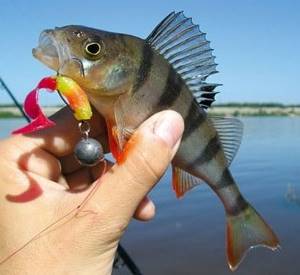
If the silicone is of high quality and soft, then offset hooks can be used for equipment; this type of equipment will give the bait a more realistic look, hiding unnecessary details. Foam rubbers with hinged fastening of baits to a sinker with ears have proven themselves quite well. When biting is inactive, such baits give a good effect, especially if they are impregnated with attractants.

Silicone baits: vibrotail, crustacean, worms.
What types of jig heads are there?
Jig heads in the equipment play the role of a load that leaves the bait in the fishing spot and to the bottom of the reservoir. The heads are made of lead. The main types of weights are the boot and the ball. The product can be with a soldered hook or only with fasteners that allow you to connect the load with other accessories of the equipment, a hook, a swivel and a clasp. For jig rigs, weights are produced with different weights, which are used based on fishing conditions. The boot is a head, which is a sinker with greater maneuverability, due to its streamlined shape in overgrown and snagged reservoirs.
Important! The round head, with the same mass as the boot, reaches the bottom faster, which makes its use more effective when fishing holes and hunting in strong currents.
Bait selection
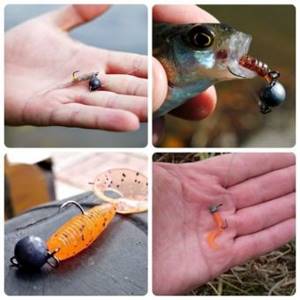
What to pay attention to:
- Use edible rubber options. Taste is important;
- choose the color white or red. Perch has acute vision that reacts to contrast. After red shades come yellow, green and brown tones. You won’t guess which color will work today;
- weight value depends on the fishing location;
- The shape plays a special role; you can choose silicone worms with vibrating tails.
Lures for catching perch with jigs
Jig baits for perch are mostly made of silicone, although in some cases foam rubber baits also show good results. Vibrating tails for perch, twisters, slugs, worms, crustaceans - these are just the most famous types of bait options. The essence of these baits, as well as their success, lies in a fairly accurate imitation of the movements of a living creature similar in shape to the bait. Adding attractants with odors to the silicone, which in most cases are unpleasant to humans, only helps the striped robber to quickly detect the bait. These types of silicones are called edible rubber.
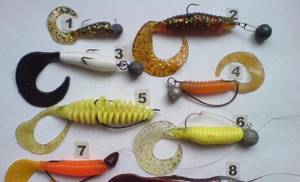
The striped predator does not need large bait. Even seasoned humpback whales happily bite on silicone, which is no larger than a matchbox in size, but smaller individuals take bait one and a half to two centimeters in size. The variety of color forms of artificial soft fish provides fishing opportunities under different light intensities and water transparency.
What kind of perch will you catch?
One of the most common fish in our Russian waters is, of course, perch. Before fishing, you should immediately decide which prey is your priority: a lot of small perches or searching for a larger humpback salmon?
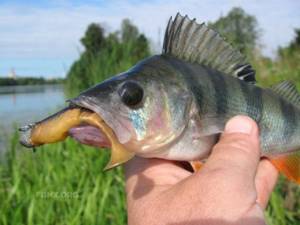
Usually, small bass gather in large schools, medium-sized ones - in smaller schools, and the most seasoned humpbacks, closer to one and a half to two kilograms, already live as hermits and lead a solitary lifestyle, as befits a real predator. Since the bait also needs to be prepared in advance for a specific perch, you need to be prepared for the fact that you may not catch a large one or you may catch only one or two. To catch these humpbacks, vibrotails, twisters, and foam fish can already be 5-15 cm in size. Moreover, quite often, perches weighing 200-300 grams are caught on fairly large vibrotails measuring 8-12 cm.
Spinning equipment and installation of silicone baits for perch fishing
Jig for perch is provided by several main types of equipment, which are used depending on the conditions of the reservoir and based on the activity of the predator. All types of tying involve the use of a standard set of accessories, including a sinker, hook, swivels and fasteners, as well as the silicone bait itself. Let’s delve into the essence of the equipment, taking a closer look at the composition of the equipment depending on their type and purpose.
Classic equipment
The classics include mounting silicone on a stationary jig head with a built-in hook. The bait and hook are selected according to the size at which the hook, passed through the silicone body, comes out with its sting in the center of the fish’s back. The weight is used depending on the depth of fishing and the strength of the current. The jig head is attached with a clasp to the main cord, or for greater subtlety of installation it is knitted directly. Use installation in open water areas with a hard bottom.
Hinged mounting on Cheburashka
More subtle equipment that gives the silicone more freedom in her natural animation. Cheburashkas are used in tandem with offset hooks, making installations in the form of non-hooking hooks, hiding the hook tip in the soft body of the fish. The selection of elements is similar to the classic type of equipment. Cheburashkas are used in areas with intense underwater thickets, in dead wood and in snags in water areas.
Retractable leash
A type of spaced rig that gives the bait complete freedom of movement. The peculiarities of catching perch with a jig using this method are based on installing a sinker at the end of the cord. The bait itself with a hook is tied on a leash of 30 cm and more than half a meter in height from the load. The sinker stretches along the bottom, raising a cloud of turbidity, which additionally attracts the predator to the fishing zone. This type of mating is used when predator activity is low.
Drop shot
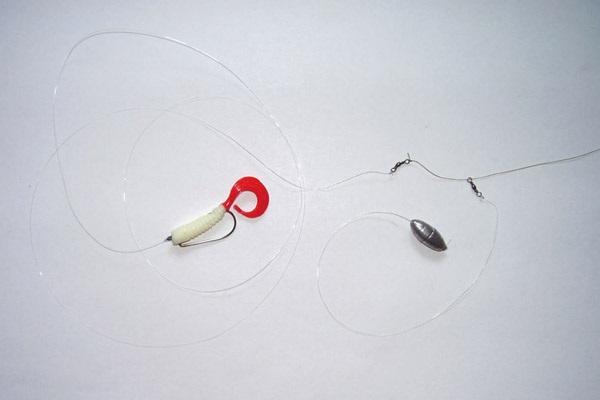
Drop-shot is a similar technique to the type of retractable leader, only the bait is attached directly to the cord, without the use of a leader. They use equipment in fast currents, using baits with high inertia, which attracts the predator by the nature of its movements.
Texas rig
One of the varieties of spaced equipment with high cross-country ability. A sliding, streamlined, often cone-shaped sinker moves along the main cord, stopping against a damper bead at the hook with bait, tied at the end of the fishing line. This technique is used when fishing for snags and driftwood, as well as for flooded trees.
Which bait to choose for successful fishing?
When selecting baits, you should choose based on the parameters of color, taste, size characteristics and shape parameters of these baits.
The taste parameters of these baits have a special effect on perch, because perch is a finicky fish in this regard. When using baits that are edible in their parameters, the quality and quantity of the catch during this fishing significantly increases.
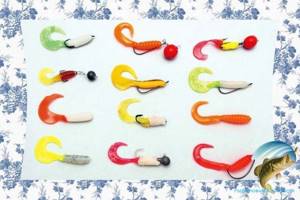
You should have different baits according to their color characteristics, because in a variety of conditions, perch is caught with baits of a wide variety of colors. Weight parameters also have an impact on the catch, which is why it is also necessary to use all kinds of bait.
For jigging methods of catching perches in August, baits based on various twisters or different types of vibrotails will be more suitable. Various types of artificial imitations of natural worms made of silicone are also suitable.
How to catch perch with a jig. Types of postings
Depending on the activity of the predator, spinning anglers use different variations of bait placements. With fishing experience, each angler determines for himself the most effective rhythms for performing montage animation, but the fundamental types on which his own developments are based remain unchanged. Our conversation will continue on the technical features of classic wiring.
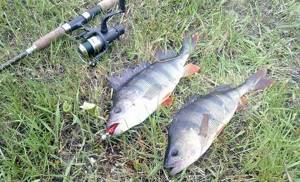
Uniform
Uniform retrieving or the so-called pyological jig, when the nozzle with a load after casting is reeled in with a reel, holding it in the water column, without touching the bottom or pauses. The bait moves with a swaying and natural movement. Fishing in the current gives the movements an even more natural look. They use wiring when fishing for active fish.
wavy
This type of feed is very attractive to the predator due to the vibration that is created by the spinner by alternating a smooth reeling with moments of its sharp intensification. These amplifications create an imbalance of vibrations that attract striped fish to the fishing site. By alternating reeling speeds, the installation moves in waves, falling to the bottom at slower stages. The wave method is used for passive fish.
Stepped
Catching perch with microjigs, medium and heavy jigs is based on this type of fishing. After casting, the load is placed on the bottom and after a micro-pause, they begin reeling, consisting of two or three powerful movements with the reel handle. At this moment, the bait jumps from the bottom and makes steps with jerks, falling again to the bottom during a pause. With such rhythms, the line is wound throughout the cast, catching the promising trajectory of the reservoir. Wiring is also used when the predator is apathetic, provoking the fish’s aggression with even sharper jerks.
Hooking and landing
The bite of a striped fish is felt as several dull pokes followed by vibration. In such circumstances, the fish in most cases self-hook, sucking the hooked bait into its throat with a powerful stream of water. Vibration indicates that the fish is firmly seated on the hook. Now the angler is required to be careful while fishing for the trophy.
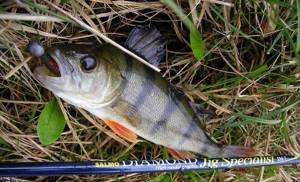
Small okushats go to winding the cord with virtually no resistance, only occasionally trembling. A large croaker puffs up its fins and, standing sideways to the reeling path, exerts significant forces, which can lead to a lip breakage during sudden movements. In the depths of fast currents, they try to catch fish along the flow of the stream, thereby reducing the force of resistance. The angler is required to be careful, which is expressed in the step-by-step selection of the cord and the release of tension through the work of the blank, either lowering the spinning rod to the water, or increasing the angle of its rise. Exhausted by such confident actions, the robber will already be tired when approaching the shore and will calmly enter the landing net using the spinning rod itself.
Types of wiring and fishing tactics
There are several main methods of casting bait used when catching perch with jigs. The fisherman must master each of them perfectly in order to experimentally find out which one is preferable on different bodies of water.
Uniform wiring
It represents uniform guiding of the bait when it moves without pauses, hesitations, deviations to the sides and without changing the depth of fishing. In this case, you need to determine the wiring speed at which bites will occur. Used for catching active perch.
This type of bait is used when fishing in spring and summer at depths of up to 3 meters, in the area of snags, dense vegetation and significant changes in relief, where other fishing can lead to hooks.
Uneven
Accelerated rewinding alternates with sharp decelerations. The bait moves in waves, periodically plunging. This method is good for catching passive perch.
Stepped
In this case, the sinker is allowed to sink to the bottom, followed by several sharp rotations of the reel, during which the bait jerks higher. In this way, the entire fishing area is examined. It works well in the fall at great depths, and also when perch becomes less active as the temperature drops.
Drawing
This kind of wiring is often used when fishing with edible rubber, mostly with classic twisters. The bait is slowly pulled along the bottom, occasionally twitching to the sides with the tip of the rod.
The retrieving speed is slow, periodically they try to lead the bait, simply dragging it with a rod, and then picking up the slack in the fishing line by rotating the reel. At the same time, you can experiment with the pace of the drive and even change the direction of movement.
Dragging works well when catching passive predators, as well as trophy perch, which may be cautious for certain reasons. The main thing here is a clean bottom and the patience of the fisherman.
Jig
But the beauty of jigging for perch isn't just that it's accessible. First of all, it is worth noting the effectiveness of jig fishing. Jig can be considered a separate fishing direction - it has its own fishing technique, wiring, and its own variety of baits and colors. Everything about jig fishing is interesting - choosing the type of bait, its color, buying this bait, casting, biting and retrieving - every stage is a pleasure. Well, the end result - the catch, is a separate joy.
In this article, the site catcher.fish will help you understand all the intricacies and nuances of jig fishing. We will talk about the selection of catchable baits for perch, fishing tactics, searching for predators, spinning rods and much more. In general, you will receive all the necessary theory and all that remains is to apply the acquired knowledge in practice.
Where is the best place to fish with jigs and perch habitat?
For the most part, striped representatives of the perch family carry out their hunting in the daytime. Especially in the early morning, at sunrise.
The striped predator can be located in absolutely any part of the reservoir, but there are also its favorite habitats. In rivers with strong currents, this fish may not be located on the current itself, but a little to the side of it, most often you can catch perches not far from the shore in order to observe the prey swimming past.
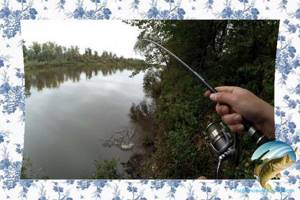
Small-sized representatives of this family prefer to hunt in shallower areas of reservoirs, and they hunt in small flocks. Large representatives of this family will be located slightly away from their smaller counterparts.
